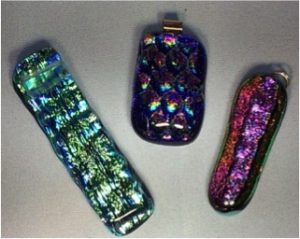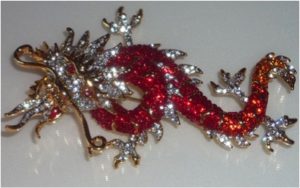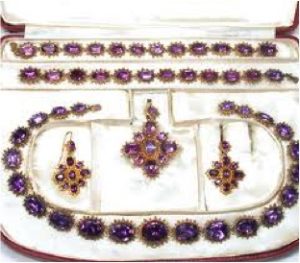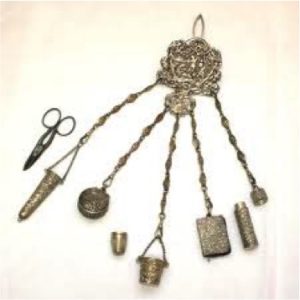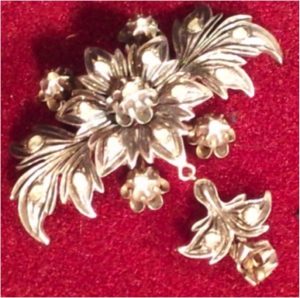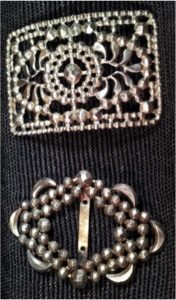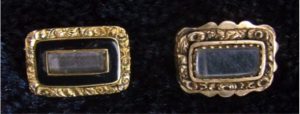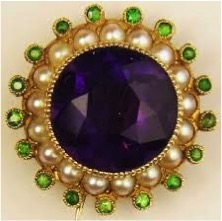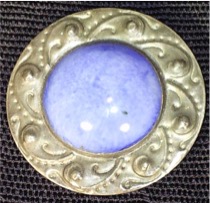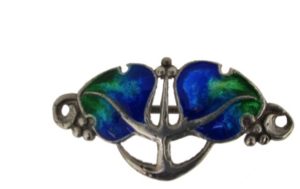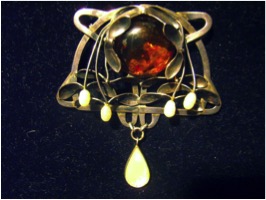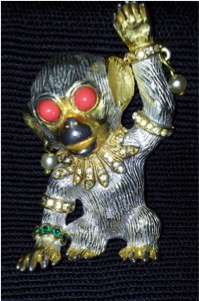Jewellery was originally made from precious stones (diamonds, rubies, sapphires and emeralds) and set in gold. This made it unaffordable for most people. Around 300 years ago, jewellers started making copies of this jewellery using cheaper materials (silver and pinchbeck, set with imitation gemstones or non-precious stones such as marcasite); the manufacture of this type of jewellery really accelerated during the Industrial Revolution as the middle class wanted beautiful but affordable jewellery.
As production methods improved and it became more accessible, women of all social stations were able to own a piece of costume jewellery. Costume jewellery really took off in the mid 20th century when designers such as Dior and Chanel began to design pieces. Coco Chanel loved using gold and faux pearls. It was also used in the movies, which increased its popularity and desirability.
Vintage fashion jewellery has achieved collectable status with the main market being for pieces with a makers mark (signed) eg Butler and Wilson or
Kenneth Jay Lane, but good quality unsigned pieces or unusual designs are also sought after.
There are four things to look for when assessing costume jewellery and its collectability.
C – condition
A – age
R – rarity
D – desirability
Costume jewellery has three main characteristics –
It is made from base metal and imitation gemstones to meet fashion trends
It is usually sold in fashion shops rather than jewellers
It is mass produced but can be ‘designer’ (eg Christian Dior)
Styles through the Ages
Georgian (1714 – 1800)
This was the age of the diamond, where the stones were more important than the setting. Designs were heavily influenced by Spain, Italy and France. Particular styles were the parure (a complete set of jewels, necklace, bracelet, earrings, brooch),
chatelaines, mourning jewellery and cameos. Popular motifs included peacocks, tulips and butterflies, The main materials used were shell (cameos), paste (from 1720), pietra dura, cut steel (from 1750), pinchbeck and rolled gold.
Regency (1800 – 1830)
Everything was handmade as it was before machine production. Stylistically, brooches were popular as they complimented the dress style of the day. Egyptian styles such as scarabs and sphinxes were also made following Napoleon’s Egyptian campaign. As manufacturing skills improved, more naturalistic styles such as flowers entremblant and pave settings were used. Materials were gold, garnet, amber, paste, pearls, coral, marcasite (fools gold) and silver filigree (which came from India).
Victorian (1830 – 1900)
This is when mass production was first introduced. Scottish styles were popularised by Queen Victoria; also tourist pieces acquired whilst on the European “Grand Tour’. Influences from other countries were also being felt. At this stage, most jewellery was only worn by married women.
Early Victorian styles include foliage, hands, hearts, serpents, Gothic and religious motifs. The mid Victorian era saw pendant earrings, gypsy settings, regency revival, mourning jewellery (after Albert’s death) and naturalistic styles, with late Victorian adding Japanese (cranes, bamboo), mistletoe, clover, wishbones, convertible jewellery and hidden meanings to the mix, such as the Suffragette brooch below.
The South African mines improved the availability of diamonds, so they were more common along with other precious stones. Semi precious stones, such as garnet, peridot, aquamarine and turquoise were increasingly used with the cabochon cut popular. Natural materials like pearls, shells, coral, bog oak and jet were also used, The Gold standard was lowered in 1854 so gold jewellery became cheaper and more available.
Art Nouveau (1895 – 1910)
This period shows a move away from mass production to hand crafted jewellery in the Arts and Crafts style.
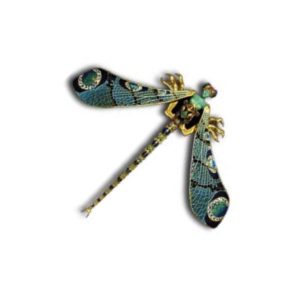 This was epitomised by Liberty of London and Sarah Bernhardt. The styles became more flowing, decadent, sensual and baroque and included butterflies, storks, orchids, sphinx, serpents, peacocks and oriental subjects.
This was epitomised by Liberty of London and Sarah Bernhardt. The styles became more flowing, decadent, sensual and baroque and included butterflies, storks, orchids, sphinx, serpents, peacocks and oriental subjects.
Materials used were opaque and semi-precious stones, including obsidian, moonstone, opals, turquoise and cats eye. Natural materials such as amber, horn, ivory and black pearls were also used. Man made materials started to be used, such as ceramics (Moorcroft, Ruskin), enamels and pewter.
Art Deco (1924 – 1939)
Art Deco was named after the Paris Exhibition of 1925 (Exposition des Arts Decoratifs et Industriels Modernes).
There are two distinct stages –
Early figurative and classical styles based on the 18th century, flowers, garlands etc, flattened and stylised to look unreal, curves turned into ovals, circles, octagonals, strong colours with exotic materials.
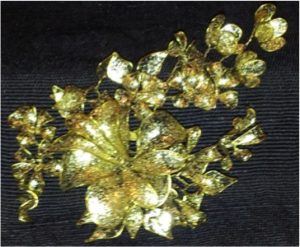
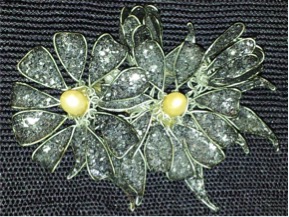
Later became ‘moderne’ with severity and abstract forms, suppressed colour with unnecessary decoration. This included an Egyptian revival following the discovery of Tutankhamen’s tomb in 1922. New improved techniques included the use of platinum to set diamonds (pave “pavement” style) and newly manufactured materials such as Bakelite and chromium along with marcasite were popular.
Styles include:
Geometric shapes (oblongs, squares, circles);


Buckle shaped links for bracelets;
Double dress clip brooches; hat brooches, often formed by rings of onyx flanking a pave diamond centre;
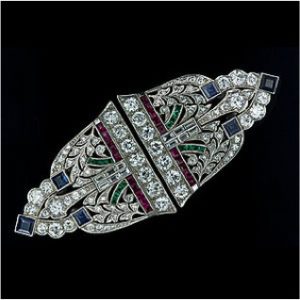
Long drop earrings (flapper style)
1940s and 1950s
This was the era of Hollywood and robust and loud styles started in the USA and became popular in Britain through film and magazine. Typical styles include folds and drapes of gold/gilt with large stones, citrine, aquamarine or ribbons of tiny square cut sapphires. Wartime limited the availability of metals leading to more use of plastics. With more women working, they wanted and could afford to emulate the styles of Hollywood actresses. Fake jewellery became big business and the top designers were lured away from making real jewellery to costume. The 40s and 50s also saw the return of the parure.
1960s onwards
There was a revolution in design as part of the “pop art’ culture, influenced by people like Mary Quant, Paco Rabane and Biba. The Hippy Trail led to an increase in the popularity of Indian style jewellery. Kenneth Jay Lane in the US designed witty quirky styles and reached his summit when Barbara Bush wore his 3 strand faux pearl necklace to her husband’s inaugural ball in 1989.
New casting techniques in 1980s saw quality jewellery made by Butler and Wilson, as worn by Diana, Princess of Wales. In America, Atwood and Sawyer supplied jewellery for the stars of Dallas and Dynasty.
Materials used included imitation diamonds made of glass, paste, diamante and rhinestone; jet and its imitations stained horn, vulcanite, bog oak and papier mache; amber and its imitations, bakelite and celluloid. To identify real amber, it is very light and floats in salt water, very brittle and will fracture like glass and smells of pine if rubbed.
The future?
Costume Jewellery is here to stay. It is readily available in a multitude of designs to suit any taste and pocket. Hi Tech jewellery which uses light diffraction to cause iridescence is upcoming and in this age of ecological awareness, repurposing old jewellery band to recreate new designs is increasingly popular.
